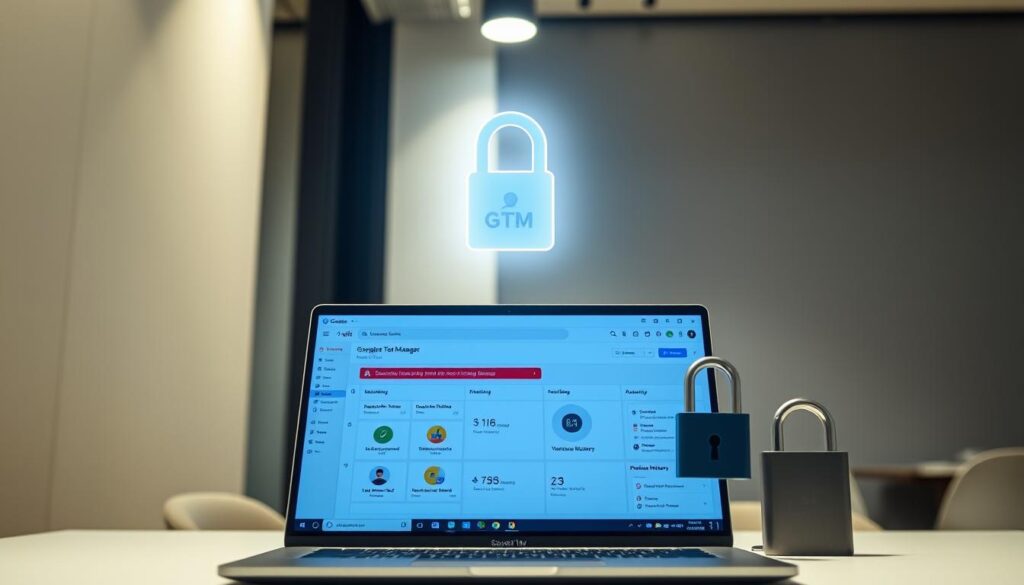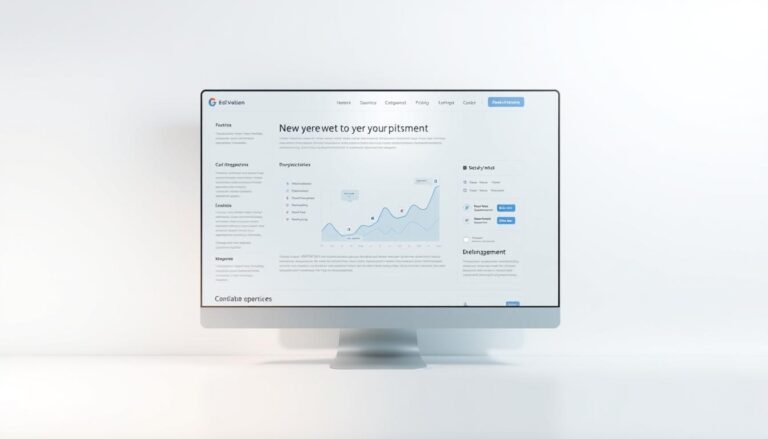In today’s world, keeping data safe in GTM automation is critical for companies. Google Tag Manager (GTM) makes adding tracking codes easier. These codes are key for understanding marketing efforts. Yet, this ease also opens doors to risks like unwanted entry and data leaks. Having strong security steps is key for protecting marketing info and data use standards. To dive deeper into GTM automation, check out this comprehensive guide.
Key Takeaways
- Understanding the significance of data security in GTM automation is crucial.
- Implementing user permissions helps prevent unauthorized access.
- Regular audits are vital for identifying security vulnerabilities.
- Data encryption is essential for protecting sensitive information.
- Training teams on security awareness enhances overall safety.
- Monitoring activities provides insights into potential breaches.
Understanding GTM Automation and Its Risks
Google Tag Manager (GTM) makes tagging easier for marketers. They can handle many tracking tags without touching the code. This tool is like a control center for tags, making marketing faster, more accurate, and efficient. But, using GTM also brings risks that businesses need to watch out for to protect their data.
GTM has strong tag management solutions but faces security threats. Knowing these threats is key to setting up good security. We will discuss common security issues with GTM, including:
- Misconfigured Tags: Setting up tags wrong can leak info or track wrong data.
- Unauthorized Access: Not enough user permissions can let others change tags and settings without permission.
- Third-Party Integrations: Risks from integrations can make the system vulnerable.
To keep your data safe in GTM, you must take steps against these threats. Companies should be aware of these dangers. They should work to keep their data private while still getting the benefits of GTM.
Want to understand these issues better? Learn more about data privacy in GTM automation. Find out how to fight these risks and safeguard your data.
Best Practices for Securing GTM Data
It’s key for organizations to secure GTM data when making data-driven choices. Using gtm automation best practices cuts down risks and makes gtm setup safer. These methods keep important info safe from unauthorized entry and dangers.
Implementing Access Controls
Setting up strong access controls is crucial for protecting GTM data. By giving roles like Admin, Editor, and Viewer, only certain people can change tags. This reduces mistakes and unauthorized modifications. Having tight gtm security rules also makes users more responsible.
It’s important to regularly check and change who has access. This keeps the security tight as staff changes happen.
Regular Security Audits
Regular security checks are vital for keeping GTM data safe. These audits find weak spots and ensure security guidelines are followed. They look at settings and find problems like repeated tags, making the defense stronger.
Good audits spot issues before they become major, protecting data collection. Making these audits a normal part of operations helps keep data safe and secure over time.
Importance of Data Encryption in GTM
Data encryption is key to protecting data in Google Tag Manager. It stops unauthorized people from seeing sensitive info. Encrypting data boosts privacy for GTM automation. Knowing what encryption types are out there and using them is crucial for GTM security.
Types of Data Encryption
There are mainly two encryption types in GTM: symmetric and asymmetric. Symmetric uses one key for locking and unlocking data, making it quick. However, it needs careful key handling. Asymmetric uses two keys, a public and a private one, for better security. Each kind is crucial for keeping data safe in GTM.
How to Implement Encryption
To put encryption in place, there are important steps to take in GTM. Use Secure Sockets Layer (SSL) for safe data sending. Also, make sure to encrypt sensitive variables in GTM. If someone grabs the data, they can’t read it without the keys. These steps help improve GTM automation privacy, earning user trust.
Maintaining a Secure GTM Environment
To ensure the safety of Google Tag Manager (GTM), apply strong practices to guard data integrity and privacy. It’s crucial to update software regularly. This helps avoid weaknesses that hackers might exploit. Adding layers of security creates several defenses against breaches, keeping sensitive info safe.
Regular Software Updates and Patches
For any organization using GTM, keeping software up-to-date is vital. Updates often fix security holes that cybercriminals attack. Not updating can leave your systems vulnerable, risking the security of your data in GTM. So, it’s smart to have a regular schedule for updating software. This step protects your organization’s data.
Layering Security Measures
For better security, it’s wise to use a combination of tools and practices. These include:
- Firewalls to stop unauthorized access.
- Intrusion Detection Systems (IDS) to keep an eye out for strange behavior.
- Secure access policies to control who can tweak GTM settings.
Putting these GTM security actions in place builds a strong defense. This approach is in line with the best ways to keep data in GTM safe. By using these GTM security functions, organizations can cut the risk of data breaches. They can also follow data privacy laws better.

| Security Measure | Description | Benefit |
|---|---|---|
| Firewalls | Acts as a barrier between trusted and untrusted networks | Prevents unauthorized access |
| Intrusion Detection Systems | Monitors for suspicious activities | Provides alerts for immediate response |
| Secure Access Policies | Defines who has permission to modify GTM settings | Limits risk of unauthorized changes |
Utilizing Data Anonymization Techniques
Data anonymization techniques are crucial for keeping data safe in gtm automation. They protect user identities and help follow privacy laws like GDPR. By using these techniques, companies can keep sensitive info safe and still gain important insights.
Data anonymization has many benefits:
Benefits of Data Anonymization
- Enhanced Privacy Protection: Anonymization keeps personal data safe from unwanted access. This builds trust between users and brands.
- Compliance with Regulations: Following laws like GDPR is easier when personal info is anonymized. This helps in safeguarding data in google tag manager.
- Improved Data Quality: Even when anonymized, data is still useful for analysis. This allows companies to get insights without risking privacy.
Best Tools for Anonymization
Choosing the right tools is vital for effective anonymization. Here are some top picks for gtm automation:
- Google Analytics: It has features to anonymize IP addresses and other personal data.
- Data Masking Software: These applications help mask sensitive data but keep it useful.
- Custom Scripts: Companies can use custom scripts in Google Tag Manager for easy anonymization.
Training Teams on Security Awareness
Security in GTM depends a lot on how prepared the teams are. Teaching teams about security awareness is key to reducing risks from unsafe actions and threats. To start, we should build detailed training programs. These will help the team learn how to implement GTM securely.
Creating Security Training Programs
We need to educate team members on the best ways to stay safe. They should learn about:
- Understanding gtm security protocols
- Recognizing phishing attempts and potential vulnerabilities
- Protecting sensitive information
- Using GTM safely, following the guidelines
Workshops and hands-on sessions help team members remember what they learn. Adding practical tasks and looking at real examples makes the training stronger.
Ensuring Compliance with Security Protocols
It’s vital to follow the security rules for GTM. Checking regularly that everyone follows these rules helps keep our security strong. Organizations need to do:
- Regular checks and audits
- Have a way to get feedback and make improvements
- Change rules when there are new threats
Building a culture that values security makes everyone more careful. Stressing the need to follow safe GTM practices makes our digital space safer.

Monitoring and Logging Activities
In the GTM world, keeping a close eye on things is key for safe data. By keeping logs of what happens and who does what, businesses can quickly spot issues. These records are crucial for understanding how things work and ensuring GTM is secure.
Importance of Activity Logs
Activity logs are a must-have for teams using GTM tools. They show all system changes clearly, helping companies stick to best practices. By checking these logs often, any strange activity can be dealt with fast. This keeps things safe and running smoothly.
Best Practices for Monitoring
To monitor well, there are some best practices to follow:
- Utilize tools that offer real-time monitoring capabilities to keep track of user interactions.
- Set up alerts for suspicious activities, ensuring immediate response to potential threats.
- Conduct regular reviews of logs to maintain compliance and identify any vulnerabilities.
- Incorporate automated reporting tools to streamline the monitoring process and enhance visibility.
| Practice | Description | Benefit |
|---|---|---|
| Real-Time Monitoring | Tools that provide immediate insights into user actions. | Quick detection of unauthorized access. |
| Alerts for Suspicious Activity | Notifications set up for any unusual patterns. | Prompt response to potential threats. |
| Regular Log Reviews | Periodic checks of activity logs. | Ensures compliance with gtm automation best practices. |
| Automated Reporting | System-generated reports on user activities. | Streamlines monitoring efforts. |
Preparing for Data Breaches
In today’s world, getting ready for data breaches is vital for any group using GTM automation. A strong response plan is the key to dealing with unexpected problems. It lists the first steps, how to talk about what happened, and who to contact. Being prepared helps lessen the damage of a breach and keeps client trust during hard times.
Creating a Response Plan
When making a response plan, companies must define roles and duties clearly. Everyone on the team needs to know exactly what to do if there’s a security issue. Doing this stresses the need to protect data in GTM automation. It lets teams move quickly to fix weaknesses. The plan should be updated often to keep up with new threats and laws.
Testing Incident Response Plans
Testing response plans regularly is crucial to make sure teams can handle breaches well. Simulations help find flaws in the plan, so organizations can make their strategies better. By often practicing and updating, companies boost their ability to face data breaches. This also shows how well GTM automation’s security works.
FAQ
What is Google Tag Manager (GTM) automation and how can it enhance my marketing efforts?
GTM automation lets marketers manage many tracking tags easily, without changing website code. It serves as a control center for all tagging. This boosts the speed, accuracy, and efficiency of collecting marketing data.
What are the common security threats associated with GTM?
GTM’s common security risks include unwanted access due to weak user permissions, data leaks, and third-party vulnerabilities. Knowing these threats is key to effective data safety strategies.
How can I implement access controls in GTM?
To put access controls in GTM, you assign roles like Admin, Editor, and Viewer. This makes sure only certain people can change tags. It lowers the chance of mistakes and unauthorized changes.
Why are regular security audits important for GTM?
Regular security checks are crucial for finding weak spots and ensuring security rules are followed. They find problems like repeated tags or setup issues early. This keeps your data gathering safe.
What types of data encryption should I use in GTM?
Using both symmetric and asymmetric encryption is crucial in GTM to guard private information. Secure data sending through SSL and encrypting private variables boosts your data privacy.
How often should I update my GTM software?
Updating your GTM software regularly and applying patches is needed for a secure GTM. Updates keep you safe from vulnerabilities that could be misused by attackers.
What are some effective ways to layer security measures in GTM?
Adding layered security like firewalls, intrusion detection, and safe access rules provides strong defense. These steps not only make GTM more secure but also help follow privacy laws.
How can data anonymization assist in protecting user identities in GTM?
Anonymizing data in GTM is key for user privacy. It complies with laws like GDPR by hiding or changing data. This way, businesses keep analyzing data without risking user privacy.
Why should I prioritize security training for my team regarding GTM use?
Security training for GTM is vital for your team to spot threats and know about safe data handling. Custom security training helps everyone follow security rules.
What should I monitor to ensure secure GTM usage?
It’s crucial to watch and record GTM activities. Logs show changes, helping spot weird actions or unauthorized access. Using real-time monitoring tools improves security.
What steps should I take to prepare for potential data breaches in GTM?
Getting ready for possible data breaches means having a strong action plan. This plan covers immediate steps, how to talk about it, and who to contact. Testing this plan often makes sure your team can manage breaches well.



